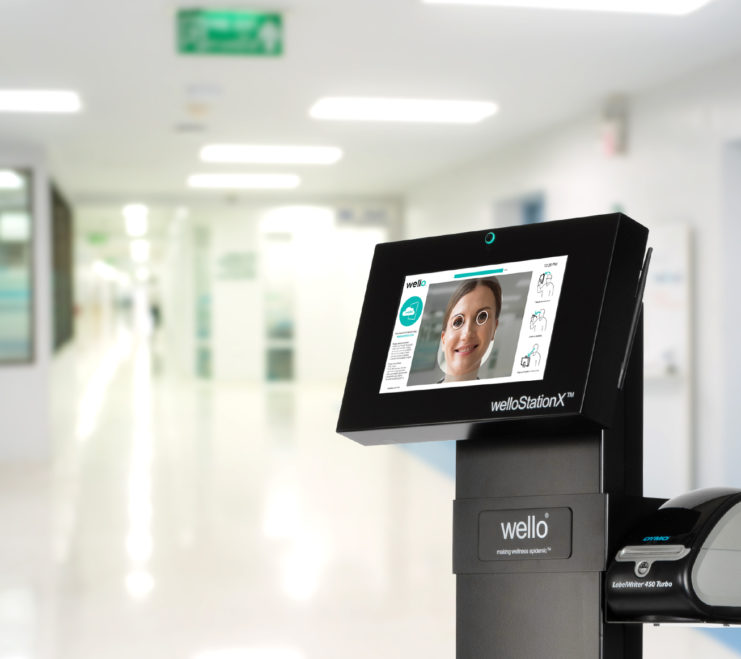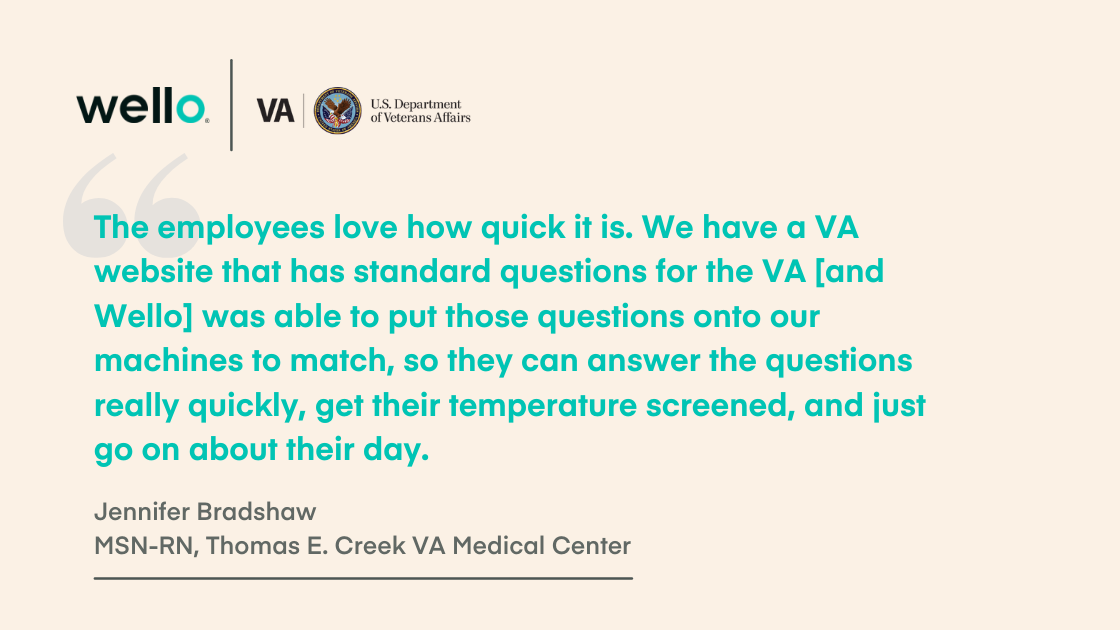The Thomas E. Creek VA Medical Center in Amarillo, TX hosts a 55-bed in-patient unit, along with a Community Living Center that has more than 120 beds and a 10-bed dementia unit. The facility as a whole provides day surgery, primary care, mental health services, and specialty services to over 25,000 veterans across West Texas.
The facility, like many others at the start of the Covid-19 pandemic, had to scramble to put contagious illness mitigation measures – like temperature and health screenings – in place to keep employees and patients safe.
After much trial and error with various manual temperature screening solutions and extensive research, the VA decided to implement several welloStationX stations throughout the healthcare facility in order to help automate the health screening of employees, patients, and visitors before entering the building. This led to a streamlined screening process and more accurate, objective health screenings.
Key Learning: By automating health screenings with welloStationX at multiple facility entry points, the Amarillo VA was able to solve many of the pain points they discovered in manual screening, such as extreme weather conditions, unreliable temperature readings, personnel availability, and unit-specific questionnaire requirements.

Learning from Experience
At the beginning of the Covid-19 pandemic, Jennifer Bradshaw, MSN, RN was a part of the team responsible for helping implement a pandemic-specific infection control strategy that included identifying possible sources of the infection at entry point into the facility. For instance, in order to continue to deliver necessary care but mitigate the risk of spreading the virus, the team decided to establish two emergency department entrances: one for people who tested positive and others for people who tested negative but still required care.
“Our main focus was on eliminating unnecessary risk while still providing necessary care,” Bradshaw said.
Of course, actually identifying individuals entering the building who carried a risk of spreading the virus required a system of risk identification, which included temperature scanning and symptom questionnaires. Unfortunately, as Bradshaw soon discovered upon early system implementation of infection control processes, there were many ineffective strategies and wasted efforts.
For instance, she noted a big problem with temperature strips and handheld thermometers.
“You couldn’t read them, and they caused people to have to get too close to other people to even try to read them.”
This proximity was counterproductive to infection control.
And last, but perhaps most problematic for their facility, she found that the unpredictable weather patterns of the area led to unreliable variability in manual temperature screening as well, especially when attempted outdoors. Extreme external temperatures ranging from very cold to very hot led to mistakes in manual temperature screening of the individuals entering the building.
Why the welloStationX?
The challenges that the VA faced in screening at entry points led Bradshaw to try to find a solution for measuring accurate and reliable temperatures. After reviewing several options, she decided on the welloStationX for four main reasons:
- The welloStationX is FDA-cleared. She explained that without FDA clearance, their team feared they may end up needing to purchase a second set of touchless temperature checks down the road, so investing upfront in an FDA-cleared touchless temperature scanner was the most financially-prudent option.
- The welloStationX stood up to the weather test. After cycling through many temperature-taking options, from thermoscanners to tympanic thermometers, Bradshaw was understandably cautious about the results from the welloStationX. Taking temperatures when people are very cold or hot can lead to inaccuracies, and so can taking temperatures outside or any place subject to gusts of air, like under and HVAC vent. So she had her team put welloStationX to the test. After ordering their initial welloStationX testing station in February–when temperatures were very cold in Texas—they placed the welloStationX at the employee entrance, where she asked her screeners to compare the system’s temperature scanning results with all the other different methods. They compared the welloStationX’s temperature results with everything from tympanic to thermoscanners and found the welloStationX to be far more reliable. “The welloStationX was more accurate pretty much every single time, even in colder temperatures outside of the [Wello’s] range recommendations. Once we did that for a couple of weeks, we knew welloStationX would be a really good fit for our facility.”
- The welloStationX offers customized screenings for different entry points. Bradshaw also explained that a very important factor in choosing welloStationX was the fact that it can be programmed to different screening requirements for different entry points. For instance, the Community Living Center’s (CLC) entrances required a different set of screening questions from the rest of the healthcare facilities—and welloStationX allowed those stations to be set up with different screening questions and was programmed to alert a different set of appropriate personal as needed if further intervention was required. General visitors and employees receive a blue sticker, but individuals entering through the CLC entrance are fitted with a pink sticker (printed on the welloStationX), to allow for easy and clear visual clearance throughout the facility. “That was a really good selling point that we could differentiate our entrances,” Bradshaw said.
- The welloStationX can be used long-term. Bradshaw explained that the last selling point of the welloStationX is its ability to be used in the future for standard health screenings upon entry, or for targeted use during flu season or other endemics.
Long-Term Strategy
Speaking of long-term use, the Amarillo VA has continued to add welloStationX stations in what Bradshaw described as a “rollout” phase for different entrance points throughout their facilities. All in all, the facility purchased a total of 36 welloStationX testing stations to utilize at different entrance points and facilities.
For instance, in the hospital, there are six main entrances, along with individual entrances to the primary care, specialty, and mental health care clinic, so each entry will have its own welloStationX testing station that can be specifically programmed for that area’s screening requirements.
She explained that because many of their visitors especially were accustomed to manual screeners, implementation of the welloStationX stations for long-term use has been done in phases—the welloStationX is introduced, along with a manual screener, to explain the process and help guide users to become more comfortable with the new process. Then, once patients, visitors, and employees are accustomed to the kiosk, manual screening is phased out, with just the welloStationX left in place for touchless temperature scanning and health screenings.
And as both patients and employees adapt and adopt the welloStationX system of touchless temperature monitoring and health screening as standard procedures for entering the VA facilities, Bradshaw noted that with the welloStationX, those protective health measures will stay in place long-term.
“I feel like some of our long-term measures that will stay in place are screening and temperature taking. And just as stuff that has happened in past epidemics or pandemics such as Ebola, so I can see screening questions staying in health care, as well as temperature taking maybe during the flu season or if anything else comes along like Covid. I don’t see this going away anytime soon.”



